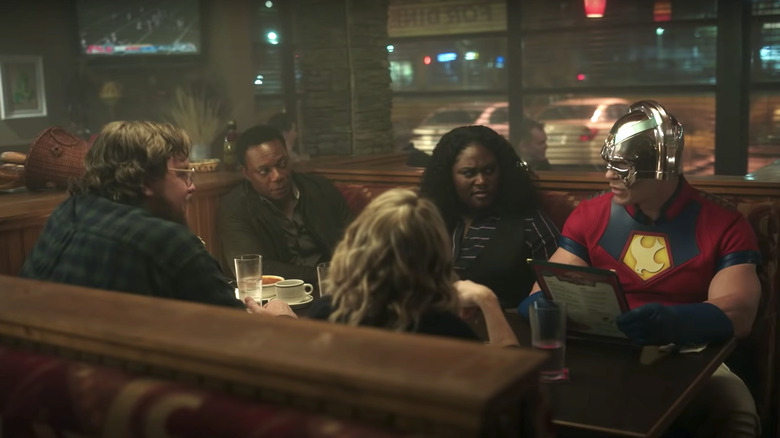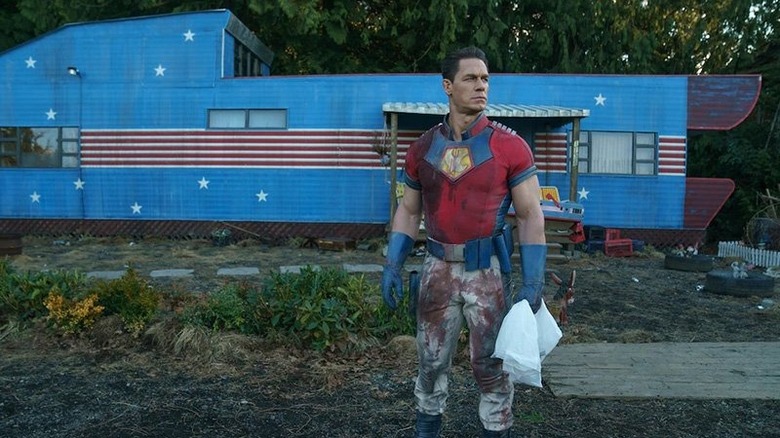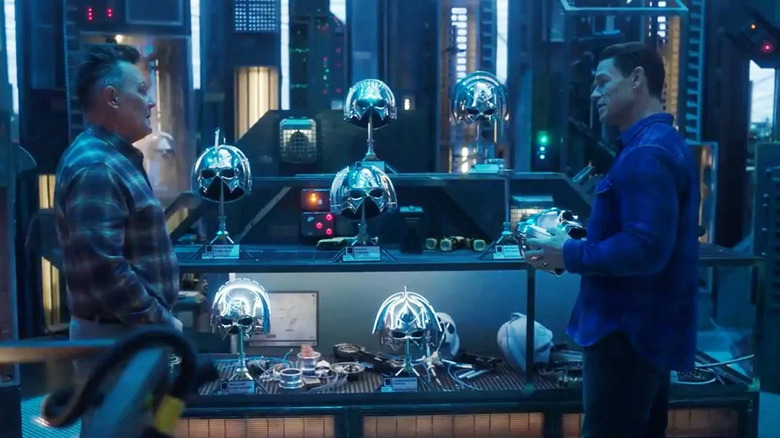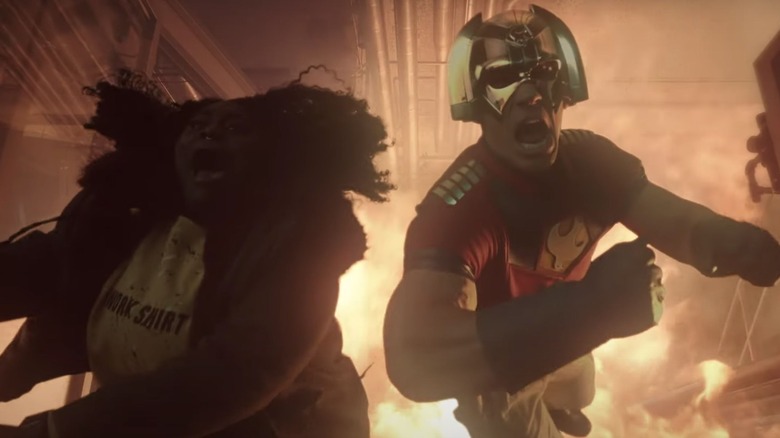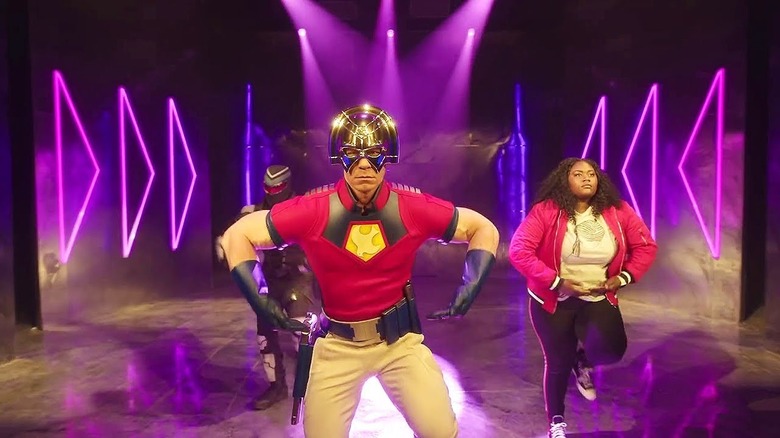Peacemaker Production Designer Lisa Soper On The Opening Credits And That Warehouse Set Piece [Interview]
Production designer Lisa Soper compares working on "Peacemaker" to a roller coaster: It's big and fast, sometimes daunting, but an absolute thrill. Once she got off the roller coaster, as she put it, she just wanted to go back on it again and again. For the production designer, the series was pure forward-momentum, as well as "incredibly, incredibly rewarding."
Whether creating a high-tech lab out of IKEA items, telling great artists to do a bad job, or taking a hammer to sets, Soper more than enjoyed creating this world with James Gunn and all involved. "At the end of the day, you would stand there and go, 'I have no idea how in this universe we actually accomplished what we did, but that was incredible,'" she explained. "Which I think is what gave us that drive to keep pushing every day that we were faced with impossibilities." During a break working on "Pretty Little Liars: Original Sin," the production designer spoke with us about the fun and rewarding times she had on Gunn's HBO Max show.
'It's 100% part of the job.'
Congratulations on your work. The world feels very lived-in, like every set has taken hits.
Well, I'm happy you said that because my set [decoration] department and my construction department, when they see me come on set, they'll all yell to each other, "Lisa is on set!" They all hide their tools, because I'm notorious for coming in and grabbing a hammer off a tool belt and scratching the walls, smashing a hole somewhere. I think it was the rocker chick's apartment where I kept telling our construction guys, "Do a sh*tty job." You're asking a professional to do something opposite of what they're trained to do, right? Don't mud the seams, we're good. It's a sh*tty place. I want to see the flaws. I want to see the nail pops. I want to see the leaks. We're going to do one coat of paint and then we're going to pack it.
Originally, I came in and it was beautiful, and it looked like a brand new hallway to a high-end apartment building, but that is not going to work. Immediately I took my coffee, I threw it on the wall. I grabbed a hammer and I just started cutting holes, kicking things, running my boot across the bottom to get all those little black marks.
I turned around at one point and the crew looked at me like I was insane, but they kind of got used to it. I would go on set, I would start pulling garbage from my purse and throwing it around, or pick up a magazine, walking around a set and ripping little pieces off of it and dropping it down and making little piles. Because it fits. I think that so much of those details of that feeling of being lived in comes from almost very literally doing a high-speed version of living in it.
Speaking of creating a lived-in environment, say for Peacemaker's home, how did a DVD copy of "Chicago" end up there?
I brought a whole bunch of DVDs. I said, "It's all bad" — and no hits on "Chicago." I just said, "Bad for this character." I don't think that he sits there and watches the new releases. He can't afford to go and buy new releases, that's a definite no. So they brought a big pile of DVDs and I went through them and I was like, "No, no, yes, yes, no, no, yes."
How about choosing the records?
That was all James, 100%. It was one of the first things that James talked to us about when we were putting this whole thing together. As I'm sure you can understand, James is very musically driven. There's nobody else I think that could really pick music to accompany a story like he can. He had everything very meticulously picked out [ahead of] time, as far as what he wanted to see, where he wanted to see it, the relevance in the scene, everything.
To the point where I think it was the day before we were shooting rocker chick's apartment, I sent the final photos. All the final details for that final approval. I went up to the rack where we had all the final records and I put them in a specific order based on what James had talked about. It was like a photo, flip, photo, flip, photo, flip, photo, flip, wide shot, photo.
I think it was one of those moments where my head decorator looked at me and she's like, "Aren't you going a little bit too excessive with this?" I just looked at her and I said, "No, this is what it should be. It's specific. We're shooting it in this order for a reason. We want people to go, 'Oh man,' and then, 'Oh sh*t,' and then, 'F**k yeah.'" There's a specific order in which you put things to be able to get those reactions at those moments.
Also, getting too obsessive is a part of the job, right?
It's 100% part of the job. If I get up one day and show up on set and there's not a problem to be dealt with or a challenge to be faced with, then I feel like I'm not doing enough, that we haven't pushed it enough. You always want to be right on that edge of balance to get that success. Also, to know that you pushed it as far as you possibly could, because we only get one chance at this.
'Everything that you can find from IKEA and a dollar store.'
How obsessive did it get over Peacemaker's home?
Like I said, he doesn't have a lot of money, right? He doesn't have a quantum chamber like his dad does. But in his mind, he's the best superhero and he wants to try to make the best of the situation that he's got. So I remember going up to my head decorator and I said, "Okay, so this is the shower and here's a shower design for his bathroom."
By the way, I love her to death, her name is Alexandra Rojeck. She's one of the best set decorators I've ever worked with in my life. But she's very deadpan. So she came up to me and she said, "Lisa, you have nine shower heads for the shower, that is ridiculous. Why are there nine showers?" And I said, "Well, you see Peacemaker wants to have a decontamination chamber, because he's a superhero. If he fights some big monster, he's got to pressure wash himself." I thought about what he would do, and this is how he would do it. She just kind of looked at me and then walked off. I came back the next day and I had my nine shower heads, which I thought were lovely and fun.
You can see there's a lot of provocative material and magazines, and most of them have like little things written on them where he's comparing himself. We also made him a magazine that he could have bought Eagly, which was like porn. It's called boobies and tits or tits and boobies, which are types of birds. It just has the birds on the front cover. We thought it was funny because it sounded like porn for birds. I think it's on the coffee table. It moved around. Sometimes it's on the counter, sometimes it's on the coffee table. I don't know if you can see it in the final cut, but it's got like a gray cover with literally the birds on the front.
[Laughs] How much discussion is there over a choice like that?
There's definitely conversation, for sure. You have to always be ready for an answer because James always wants to know the history of something and a purpose. And that's what made this so challenging, but also very exhilarating for us, and why we went to this type of detail and this level of detail with each of the characters. Rocker chick's place has a bunch of cat sh*t in it, but there's no cat. I was asked, "Where is the cat?" Well, obviously she ate it. You have to be quick with answers.
If you look around and it's like, "Okay, this is this, he got this when he was a kid, he got this when he moved out of his place, he moved this, remember then this, he picked up off of the crime scene here and this he kept because he thought it was stupid, or this he thought that he could turn into a weapon." James would come in and he would take a look and he would say, "What's this?" Sometimes he's like, "Okay." And then sometimes he's like, "No, it's too much." And then you back it off and you replace it with something else. It was fun because it was a way to explore the characters with him.
Obviously, Peacemaker's dad's lab is the most advanced set. What work went into that set?
Everything that you can find from IKEA and a dollar store, because that's literally what it's made out of. We made the shapes based off of the idea of a Hoberman sphere. We started looking at things like quantum physics. How can we make this thing believable? It's very easy to make something unbelievable if you don't want it to be grounded. But when you have a mandate of having things that are grounded, start with as close to reality as possible, even with the impossible, and then build out from there.
That was one of the reasons why I chose to put together the actual towers in the chamber like I did. It was using everyday household items that we look at all the time. It was a little bit more reachable in our universe. It wasn't just molded plastic with melted sugar and painted brick white. It actually was made by hands in our world. So, all of the little control pieces that are on the sides of the towers, those are cutlery trays from IKEA that are upside down.
I never would've guessed IKEA.
Oh, yeah. They're very cheap. There were also little mini paint trays that we got from the dollar store that put those upside down. Taking something, inverting it or putting it backwards, it gives some type of a dynamic shape. It's the same kind of approach that was used in making a lot of the ship details in the original "Star Wars” or "Alien" when they didn't have any money.
It wasn't that we didn't have any money for this — it was partly for time and, again, trying to keep it grounded in reality. We send people out one after another to pick up just random junk. There's air filtration filters that you use to change your furnace filter, and those are lined all across the top. And then once you spray paint from it, it's some type of exhaust for these big towers that are basically made of cardboard.
'We started to feather in the character and enough life on top of it.'
The rest of Auggie's house, rightfully so, feels so empty and cold.
That was actually another one of the sets that played on that razor's edge of going too far, one way or another. Because you look at his father's character and there's a lot of ways that place could have been interpreted. I think that my first gut instinct when I started designing the place was very, very obscure and very military and very clean and very organized.
I had a conversation with James and he said, "It's too far and he is not human enough and realistic enough here." Then, we started to feather in the character and enough life on top of it. I'd walk into a room and I'd say, "Okay, where did you read the newspaper?" He reads the newspaper in the same place every day. Where is his favorite chair when he watches TV? What's this guy's routine, right?
I think those what really helped us pull that together, like a stupid lamp in the back. I think we bought 10 or 12 different lamps to go on the corner by the table, just to make sure that we had the right one. It was just a nonchalant lamp that was picked up, that he didn't care about, but it functioned fine. It wasn't too designer, but it wasn't too tacky so it could be cool. It just seems like such a mundane thing, but I think that those are the things that really helped build that character and bring them to life.
Since one of the show's biggest set pieces takes place in the warehouse, how did you want to help create the clear sense of geography of that space for the action?
That was amazing, because we had the script ahead of time before we had access to Rosemary Rodriguez, our wonderful director for that episode. We needed to make sure that everything was prepped as much as possible ahead of time. And that set piece, none of that lays out the way that it lays out. There were combinations of places, set pieces that were built on the stage. There were pieces that were at this location smattered all over the place.
I had this booklet, basically, where I could take the director through. I would take James through it and then I would take Rosemary through. I would say, "Okay, so if the truck pulls up here and they break out into two teams, this is this team's journey and this is the way they walk in and this is where they would go here and this is where they would go here. And then, they turn this way over here and then they get into this space, this happens here. In the meantime, from the other side of the building we've got the B-team coming in over here, they're upstairs."
All of this was literally all over the place when you looked at it in reality, so it was very confusing, but once we went over it and over it and over it and over it again, then it then started to feel like it had a flow.
Pretty sure I bought every single cardboard box in the lower mainland. It was just more, more, more, more. The conveyor belts were all designed between myself and working with our office special effects team [and with special effects supervisor] Alex Burdett. We just put blue on a bunch of those fast, because it was a closed down beer processing facility. There were these big cones on the top of the ceiling and we looked at those and were like, "Hey, we put some blue here and we can just make that look like that's goo coming out, right?"
'I was thinking about 'Maximum Overdrive.''
Of course, people are talking about how fun those opening credits are. How'd you end up with the design for the musical number?
I love this question. It's funny because as soon as the show came out, everybody started freaking out about the credits. So, they were supposed to be in the HQ, which was going to be cool and awesome. We looked at it and I was like, "I don't know, man." Remember "Guardians 2" with that big dance number with that alien? We need more space that we need to go through.
I think it was three days before we were ready to shoot it when James responded and he said, "You know what, guys? I want to do this on stage." No problem. So immediately it was like panic, oh God, where are we going to do this? We got to run. Jesus Christ. So, we shot at this one location. I think it was a juvenile center or something like that. It was an old gymnasium. It only had hand door access, there were no big loading doors or anything like that. It was a challenge.
I said, "Okay, I got to go home, I got to draw." So me and my husband, we were sitting down and drawing overnight. I think we got around 30 different designs, and it was literally bantering back and forth. I would say, "Okay, well, what's another idea?" Because James mentioned, as a reference point for me to start with, the old like '60s, '70s variety shows. I did a whole bunch of designs and weird shifting shapes and then I had to yell out to my husband, "What about bolts?" He was like, "Yeah, yeah, we would have the moon."
Then I did these bolts and a moon with like some lightning bolts that would come in. Also, there was another design with a truck backing up. I was thinking about "Maximum Overdrive," plus there was that Statue of Liberty. Literally anything we could possibly think of I was just like, "Okay, bam, bam, bam, bam, bam."
It was about five o'clock in the morning. I think we got 29 designs. I said, "I just need one more." And my husband said, "You're good, James is going to love one of these. You literally have anything possible here for a stage." And I said, "I'm just going to do one more." He said, "No, we've got these '80s hair bands and everything." And I said, "What if we just did something completely different? He's probably not going to go for this, but at least I'll toss it in as an option."
It's almost like a cover from one of those '80s hair bands with neon and crazy reflective surfaces and all that. Be kind of simple, right? That was the fastest design that I did, and it was the last one. And then I sent them all to James. He liked it. He picked the last one that we had done. And that was one of the fastest and the most expensive sets I'd ever put together. But we did it. It was super, super, super worth it. It's definitely one of a kind.
"Peacemaker" is now available on HBO Max.
